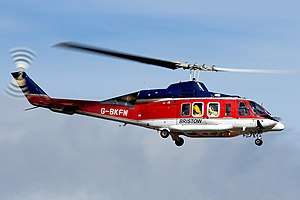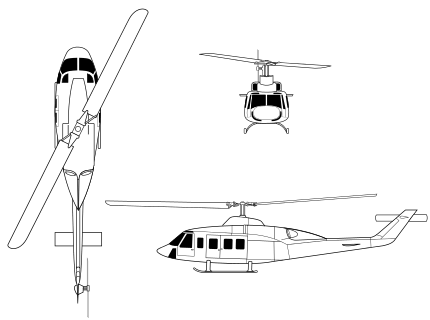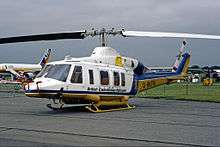Bell 214ST
The Bell 214ST is a medium-lift, twin-engine helicopter descended from Bell Helicopter's ubiquitous UH-1 Huey series. Though it shares a type number with the somewhat-related Bell 214, the 214ST is larger and of quite different appearance.
| Bell 214ST | |
|---|---|
 | |
| A Bristow Bell 214ST over Aberdeen, Scotland | |
| Role | Medium-lift helicopter |
| National origin | United States |
| Manufacturer | Bell Helicopter |
| First flight | February 1977 |
| Introduction | 1982 |
| Primary users | Peruvian Air Force Royal Brunei Air Force Royal Thai Navy Iraqi Air Force (historical) |
| Produced | 1979-1993[1] |
| Number built | 96[1] |
| Developed from | Bell 214 |
Design and development
The Bell 214ST was originally developed as a military project from the Bell 214B BigLifter, specifically for production in Iran and the development by Bell was funded by the Iranian government.[2] The fundamental difference was the replacement of the Model 214's single Lycoming LTC-4 turboshaft engine with two 1,625 shp (1,212 kW) General Electric T700 engines, to improve the helicopter's hot and high performance and improve safety. An interim twin-engine conversion of a Model 214 flew on 15 February 1977 in Texas,[3][4] Testing was successful, and Bell decided to press forward with a definitive twin-engine Bell 214ST, with a fuselage stretched by 30 in (76 cm) and a revised main rotor of greater diameter. Iran changed its production plans, with 50 Bell 214A and 350 214STs to be built at the new production plant to be set up at Isfahan, Iran.[5]
Work started on three conforming prototypes in 1978.[6] The overthrow of the Shah in 1979 resulted in the cancellation of Iran's orders. By this time the new helicopter had attracted sufficient interest from other potential customers for Bell to continue with the project and build the 214ST at their Dallas-Fort Worth facility instead. As a result, it was launched as a civil helicopter, rather than a military one.[2][7][8]
The first of the three full 214ST prototypes flew on 21 July 1979.[8] Manufacturing of production 214STs began in 1981. Type certification from the FAA and CAA for visual and instrument flight rules was awarded in 1982.[9] The military variant followed into production with helicopter deliveries commencing in 1982.[3]
The Bell 214ST included major design changes from the Bell 214. The Bell 214ST has a larger, stretched fuselage with seating for 16-18 passengers,[10][11] and two 1,625 shp (1,212 kW) GE CT7-2A engines.[12] The helicopter introduced some ground-breaking innovations for Bell, including a one-hour run-dry transmission, fiberglass rotor blades, elastomeric rotorhead bearings, and the option of either skid or wheeled landing gear.[2] The helicopter has a cockpit door and a large cabin door on each side. The 214ST has a fuel capacity of 435 US gallons (1,650 L). An auxiliary fuel system could be added.[11]
The Model 214ST was the largest helicopter that had been built by Bell at that time[10] (since surpassed by the Bell 525 Relentless)[13] The ST was originally an acronym for "Stretched Twin", but was later changed to "Super Transporter".[10][12] Bell built a total of 96 214STs with production ending in 1993.[1]
The military operators included Iraq (48),[14] Brunei (1), Peru (11), Thailand (9) and Venezuela (4).
The 214ST was replaced on the Mirabel plant production line by the smaller Bell 230.[3]
Operators
Military operators
Former operators
- British Caledonian Helicopters[9]
- Bristow Helicopters[25][26]
Aircraft on display
United States
- Flying Leatherneck Aviation Museum at MCAS Miramar, California[28]
Specifications (214ST)

Data from International Directory of Civil Aircraft,[10] Complete Encyclopedia of World Aircraft[6]
General characteristics
- Crew: 1 or 2
- Capacity: Internal: 16 or 17 passengers or equivalent cargo; External: 8,000 lb (3,630 kg) sling load
- Length: 49 ft 4 in (15.03 m)
- Rotor diameter: 52 ft 0 in (15.85 m)
- Height: 15 ft 11 in (4.84 m)
- Disc area: 2,124 ft² (107.3 m²)
- Empty weight: 9,481 lb (4,300 kg)
- Max. takeoff weight: 17,500 lb (7,938 kg)
- Powerplant: 2 × General Electric CT7-2A turboshaft, 1,625 shp (1,215 kW) each
Performance
- Maximum speed: 143 knots (165 mph, 264 km/h)
- Cruise speed: 140 knots (161 mph, 259 km/h)
- Range: 435 nmi (500 mi, 858 km)
- Service ceiling: 10,400 ft (3,170 m; ceiling for hover in ground effect)
- Rate of climb: 1,780 ft/min (9.04 m/s)
See also
Related development
Aircraft of comparable role, configuration and era
References
- "Bell 214ST Supertransport" (subscription article). Jane's Helicopter Markets and Systems. Jane's Information Group, November 28, 2011.
- Apostolo, Giorgio. The Illustrated Encyclopedia of Helicopters, p. 54. New York: Bonanza Books, 1984. ISBN 0-517-43935-2.
- Green, William, Observers Aircraft, p. 228. Frederick Warne Publishing, 1991. ISBN 0-7232-3697-6.
- Air International October 1982, p. 165.
- Air International October 1982, pp. 165–166.
- Donald, David, ed. "Bell Model 214ST". The Complete Encyclopedia of World Aircraft. Barnes & Nobel Books, 1997. ISBN 0-7607-0592-5.
- Lambert Flight International 30 June 1979, p. 2345.
- Air International October 1982, p. 166.
- Pelletier, Alain J. Bell Aircraft Since 1935. US Naval Institute Press, 1992. ISBN 1-55750-056-8.
- Frawley, Gerard. The International Directory of Civil Aircraft, 2003-2004, p. 44. Aerospace Publications Pty Ltd, 2003. ISBN 1-875671-58-7.
- Lambert, M. "Bell 214ST". Jane's All the World's Aircraft 1990-91. Jane's Information Group, 1990. ISBN 0-7106-0908-6. (subscription article)
- Green, William. Observers Aircraft, p. 224. Frederick Warne Publishing, 1987. ISBN 0-7232-3458-2.
- 'Relentless' 525 To Be Largest Bell Helicopter
- Timmerman, Kenneth R. The Death Lobby: How the West Armed Iraq. New York: Houghton Mifflin Company, 1991.
- "World Air Forces 2013" (PDF). Flightglobal Insight. 2013. Retrieved 19 February 2013.
- "Fuerza Aerea del Peru Bell 214ST". Retrieved 17 February 2013.
- "HTS Aircraft". htshelicopters.com. Retrieved 17 February 2013.
- "Blackwater Worldwide (Xe Corp)". bingo.com.pk. Archived from the original on November 9, 2009. Retrieved 17 February 2013.
- Evergreen International Aviation (September 2009). "Evergreen Helicopters Fleet". Retrieved 2009-09-29.
- "災害対策用ヘリコプター「あおぞら号」". Archived from the original on 2017-08-22.
- "CHC Helikopter Service AS Bell 214ST". nordicrotors.com. Retrieved 17 February 2013.
- "Rebuilding Iraqi air force will take time". stripes.com. Retrieved 17 February 2013.
- "Bell 214ST Iraqi Air Force". Demand media. Retrieved 17 February 2013.
- "Thai Navy Bell 214ST". jetphotos.net. Archived from the original on 2013-11-01. Retrieved 17 February 2013.
- "The last Bell 214ST helicopter - Page 7" (PDF). bristowgroup.com. Retrieved 17 February 2013.
- "Bell 214ST G-BKFN". flightglobal.com. Retrieved 17 February 2013.
- "fuerza aerea de venezuela Bell 214ST". Retrieved 17 February 2013.
- "F3D Skyknight/124630." Flying Leatherneck Aviation Museum. Retrieved: 16 January 2015.
- "A Big Lifter From Bell". Air International. Vol. 23, No. 4, October 1982. pp. 163–169.
- Lambert, Mark. "214ST: Bell's Super Transport". Flight International. Vol. 115, No. 3667. 30 June 1979. pp. 2345–2348.
External links
![]()
